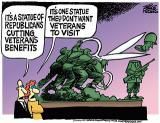One can't forget how the country ignored us Vietnam vets, on many issues and that carries forward into the countries following wars and the few who didn't as we fought for the recognition of PTS, PTS now can't be, finally, easy to ignore when those served don't want to sacrifice, what always was and not only in the Military and War Theater ranks but also the civilian populations.
November 7, 2013 - Although exposure to trauma has always been a part of the human condition, the evolution of what is now known as Posttraumatic Stress Disorder (PTSD) since the first Armistice Day, Nov. 11, 1918, is particularly fascinating. Armistice Day became Veterans Day in 1954 to honor all Veterans.
For Veterans Day, let’s reflect on how far we have come since the first Armistice Day in our understanding of this mental health problem.
In 1919, President Wilson proclaimed Nov. 11 as the first observance of Armistice Day, the day World War I ended. At that time, some symptoms of present-day PTSD were known as “shell shock” because they were seen as a reaction to the explosion of artillery shells. Its symptoms included panic and sleep problems, among others. Shell shock was first thought to be the result of hidden damage to the brain caused by the impact of the big guns. That changed when more soldiers who had not been near explosions also had its symptoms. Treatment was inconsistent. Soldiers often received only a few days’ rest before being returned to the war zone.
In World War II, the shell shock diagnosis was replaced by Combat Stress Reaction, also known as “battle fatigue.” Today’s Combat and Operational Stress Reaction diagnosis reflects serious reactions to a high-stress or combat-related event. COSR is a normal, brief reaction – less than 72 hours – from which complete recovery is expected. A PTSD diagnosis, however, requires that its symptoms last at least a month. read more>>>
























No comments:
Post a Comment